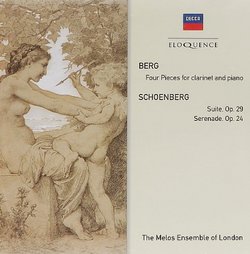Oh là là!--Une Embarras de Richesses de Schönberg...
Sébastien Melmoth | Hôtel d'Alsace, PARIS | 06/06/2010
(5 out of 5 stars)
".
Oh là là!--Une Embarras de Richesses de Schönberg...
.
These 2010 remastered performances by the Melos of London (originally issued in the 1960s on L'Oiseau-Lyre LP) comprise without doubt one of the choicest Schönberg discs currently on the market, featuring his THIRD Period dodecaphonic suites (Opp. 24 & 29).
The Melos Ensemble of London (1950-73)--predecessor to today's Orpheus Chamber Orchestra--was comprised of twelve players headed by violist Cecil Aronowitz (frequent collaborator with the Amadeus Quartet) and the great English clarinettist Gervase de Peyer. The Ensemble specialized in multi-instrumental chamber works (e.g. Beethoven's Septet, Schubert's Octet, etc.).
Moreover, avant-garde Londoners have been enthusiastic about Schönberg since he accepted Sir Henry Wood's invitation to conduct his orchestral works in Queen's Hall prior to the First World War (Jan. 1914).
In these performances the Melos offers precise and affectionate readings of marginally wider breath than Atherton's London Sinfonietta (1974), Boulez' Ensemble InterContemporain (1979), or Craft's 20th Century Classics Ensemble (1994).
The works featured here fall within a special set Schönberg composed in the 1920s & `30s with a burst of energetic inspiration following the formulation of his own 12-tone technique. Schönberg's aesthetic and intellectual integrity demanded more than simple free pantonality (à la Stravinsky) could provide: it required an explicable system of organization which could parallel centuries of tonal harmony. And having fabricated a rational methodology for systematized pantonality his muse was set free to range far and wide in imagination's cosmos, resulting in a cluster of scintillating works comprised of Opp. 24-36--(including his grand opera Moses und Aron).
With the establishment of his 12-tone technique, Schönberg was anxious to assert its historical continuity within the stream of Western art-music by implementing stylized dance forms found in the keyboard and orchestral suites of Bach et alii: this is apparent in the permutated ouvertüren, gigues, waltzes, polkas, marches, and minuets found in these early dodecaphonic pieces--extending unto lieder ohne worte, ländler, and the jazzy foxtrot.
Each of the suites are septets comprised of a string trio with a quartet of unusual combinations: Eb clarinet, bass clarinet, guitar and mandolin in Op. 24; piano and three clarinets (Eb, Bb, and bass) in Op. 29.
These extraordinary ensembles provide Schönberg with a colourful palette of patterns, timbres and textures which he implements with his sophisticated genius of accents, rhythms and syncopations.
He utilizes every type of string harmonics including pizzicato, perdendosi, am Steg and sul ponticello.
To top it all off, the Serenade features an humorously bathetic setting of a Sonnet by Francesco Petrarca (1304-74) sung in German translation by a bass-baritone: it's a pièce de résistance, but the ensuing Song Without Words is the understated climax most quintessentially representative of Schönberg's ethos.
Cover-art features the charming and subtly erotic Bouguereau lithograph, Love's Resistance (1885).
Voilà!--c'est tout.
.
Schoenberg: Suite / Wind Quintet
Arnold Schoenberg: Serenade/Five Pieces For Orchestra
Schoenberg: Serenade; Variations, Op. 31; Bach Orchestrations
Schoenberg: Serenade/Septet-Suite
Schoenberg: Five Orchestra Pieces, Survivor from Warsaw
.
Beethoven: Sept in E Flat / Serenade for Flt Vln
Schubert: Piano Trios 1 & 2; Trout Quintet; Adagio In E Flat D.897 [Australia]
Hummel: Septet, Op.74, Quintet, Op.87; Weber: Clarinet Quintet, Op. 34 [Australia]
20th Century French Chamber Music
Shostakovich: Pno Qnt / Prokofiev: Qnt in G Minor
."

